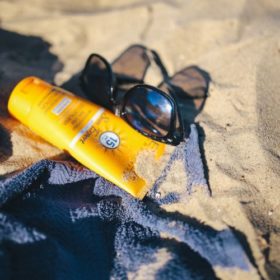
“A study in 2015, published in the journal Archives of Environmental Contamination and Toxicology, found the chemicals have a range of effects on coral, including mortality in developing coral, bleaching of coral and genetic damage to coral and other organisms. It also found both chemicals can induce feminisation in adult male fish and increase reproductive diseases in creatures from sea urchins to parrotfish and mammal species similar to the Hawaiian monk seal. The chemicals can also induce neurological behavioural changes in fish and have possible impact on the many endangered species found in Hawaii’s waters, including sea turtles. [emphasis added]”
“The study found oxybenzone had a toxic effect at a concentration of 62 parts per trillion – equivalent to one drop in six-and-a-half Olympic-size swimming pools. [emphasis added]”
Certainly the environmental impact of these chemicals is a concern. However what I found absolutely jaw dropping is there is no mention whatsoever in this article about the potential impact on human health. Instead, there is only a rebuttal comment about how the lack of sunscreen impacts human health, which implies that all sunscreens must contain these toxic ingredients.
As a person who has career experience in toxicology, pre-clinical and clinical trials, and an educational background in chemistry and biology, I am very familiar with the fact that toxicity of compounds often occurs across many different species, even if their biology is somewhat different. The article above even mentions that “mammal species similar to the Hawaiian monk seal” have an increase in reproductive diseases as a result of exposure to these two chemicals. Then wouldn’t it stand to reason that humans, also being mammals, may likely also develop the same type of diseases as a result of exposure? Yet no one dares to put 2 + 2 together in the article, because that would A. require common sense, and B. would be just too controversial. (Or might result in a loss of advertisers and affect bottom line revenue to the paper. I am speculating here, so don’t go writing nasty letters to the paper.)
Don’t get me wrong, of course humans have a responsibility for being mindful about how we treat the environment. But, how we do that (government action versus private action) is a matter for debate. But what about the impact on human health? Are human life and human health expendable, while those of marine life are not? Don’t we also have at least as much responsibility to not poison people with products that are supposed to be protecting them? Here at Nature’s Complement, we actually believe that we should treat our bodies at least as well as we treat our planet.
I thought that perhaps this article was just an exception, and that other articles on this topic might actually make the connection. So I found a couple other articles providing coverage of the topic. One from the New York Times, and one from the Washington Post. Both of these articles also fail to mention the potential health impact of these chemicals on humans. However the New York Times article does mention that “An estimated 14,000 tons of sunscreen is believed to be deposited in oceans annually” which I found to be an interesting statistic. At least the Washington Post article references a real peer-reviewed scientific publication, and also references the Hawaiian bill itself which states: “Furthermore, oxybenzone and octinoxate appear to increase the probability of endocrine [hormonal] disruption.”

However, the most despicable content is also found in the Washington Post article. Several things in fact:
“The Star Advertiser reported that the proposed law, […] was opposed by ABC Stores, the Hawaii Medical Association, the Hawaii Food Industry Association, Chamber of Commerce Hawaii, the Personal Care Products Council and Bayer, which [Bayer] manufactures sunscreens by Coppertone.”
“Bayer said in a statement that […] “eliminating the use of sunscreen ingredients considered to be safe and effective by the FDA with a long history of use not only restricts consumer choice, but is also at odds with skin cancer prevention efforts. What has been scientifically proven is that exposure to UV radiation from the sun causes skin cancer.” The Bayer commentary just fails to mention that the very same chemicals they are advocating also have scientific evidence to show that they likely increase the risk of getting skin cancer.
“Johnson & Johnson, which owns Neutrogena, said it agreed with the position taken by its trade organization, the Consumer Healthcare Products Association […] Oxybenzone and octinoxate, found in the majority of sunscreens, are safe and effective over-the-counter (OTC) active ingredients recognized by the Food and Drug Administration (FDA) as important aides in decreasing the risk of developing skin cancer.” As if everything the FDA has approved is safe. Because clearly we’ve never had a medication approved by the FDA later pulled off the shelves due to deaths or other harm (Vioxx and Fen-Phen immediately come to mind).
Sarcasm aside, here is my response to Bayer and Johnson & Johnson: It is true that UV radiation can cause skin cancer. However there is also a large amount of peer reviewed scientific data showing that using organic chemical sunscreen ingredients such as Octocrylene, oxybenzone, and octinoxate are as likely to cause skin cancer as UV exposure. So their health hazards completely negate any benefit of their use.
I address these topics in my article “Do You Really Need A Sunscreen?” as follows:
“Octocrylene, oxybenzone, and octinoxate are also a photosensitizers as noted in this study, (which seems completely contradictory to use as sunscreen ingredients). They are also pro-oxidants which can increase free radical damage to skin cells after 60 minutes of sun exposure. In other words, these ingredients are only effective for the first hour of exposure, but after an hour, they cause more skin damage than if you were to not use anything at all. Thus it makes no sense to use these as sunscreen ingredients.”
So in summary, on this topic, Bayer, and Johnson & Johnson (and anyone else who takes this position), is either fully incompetent or fully corrupt, or both. They don’t care about your health, or the environment; they just want your money. I would recommend consumers boycott at least all of their sunscreen products (other products to be determined on a case by case basis).

So now that I have gotten that out of the way, what does this ban mean to consumers? Essentially it provides additional evidence that NONE of the organic chemical sunscreen active ingredients approved for use by the FDA are actually safe. (Zinc oxide is considered a mineral sunscreen, not an organic chemical sunscreen.) I wrote about this topic extensively in my article “Do You Really Need A Sunscreen?” In that article I even pointed out that: “Octinoxate (also known as methoxycinnamate) may cause DNA damage as demonstrated in this study: “Different DNA damage response of cis and trans isomers of commonly used UV filter after the exposure on adult human liver stem cells and human lymphoblastoid cells.“ I also pointed out that: “Oxybenzone (also known as benzophenone-3) is an estrogenic endocrine (hormonal) disruptor as evidenced by the following studies:
Endocrine-disrupting effect of the ultraviolet filter benzophenone-3 in zebrafish, Danio rerio.
You may also be interested in reading our article on sunscreen titled, “SPF: What Does It Mean, And Why You Should Care“
The hard truth of the matter is the ONLY “FDA approved” sunscreen active ingredient that is both safe and effective is zinc oxide. Every other “FDA approved” sunscreen active ingredient is going to cause or contribute to significant pathologies. The science supports this position. Does this mean that you have to settle for limited protection from the sun? Not at all. There are several other natural compounds that have scientific research evidence to support that they are both effective and safe at providing protection from various consequences of sun exposure. These include, protecting DNA from UV induced damage, reducing UV induced inflammation, providing oxidative protection, and several other mechanisms. However the FDA is too bureaucratic and too influenced by chemical manufacturers to get around to approving them for use. You can also read more about these alternative ingredients in my article “Do You Really Need A Sunscreen?“

The good news is we offer a sunscreen that includes these safe, effective, alternative ingredients. Not only does our sunscreen protect you from sun damage, but it does so safely, and without causing harm to the environment. Our Shield Sunscreen product actually contains several safe, effective and innovative ingredients that you won’t find in most other sunscreen products. However, for FDA legal compliance reasons, the only officially “active ingredient” we are permitted to list is zinc oxide.
So we encourage you to check out our Shield Sunscreen. You can read more about it on the product page, and we offer a 100% money back guarantee on all of our products. Good for you, good for the environment. Problem solved.
For Health,
Rob
Nature's Complement is a participant in the Amazon Services LLC Associates Program, an affiliate advertising program. If you purchase products on Amazon through any of our affiliate links, we get a small percentage of the transaction, at no extra cost to you. We spend a lot of time writing the articles on this site, and all this information is provided free of charge. When you use our affiliate links, you support the writing you enjoy without necessarily buying our products. (However we would appreciate if you would do that too!) Thank you for helping to support our work, however you choose to do so.
These statements have not been evaluated by the Food and Drug Administration. This information and/or products are not intended to diagnose, treat, cure or prevent any disease.


